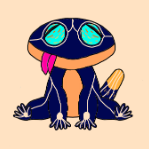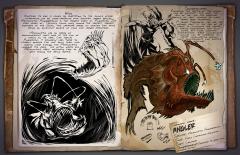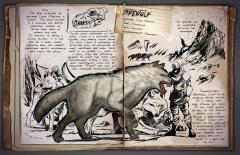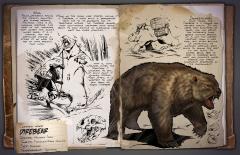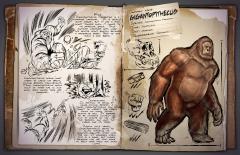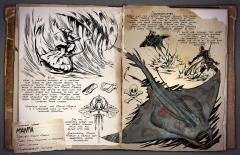Search the Community
Showing results for tags 'no saddle'.
-
USE PLASMA FOR AMOUR AND WEAPONS (sorry there is no dossier I could not fit it in) Cretaceogekko burmae is a unique specimen of extinction, in the wasteland of the cities and in the Crater forest I have seen it constantly hanging from ceilings and walls. Unlike most animals it has a unique hunting strategy. In an enclosed space with tight walls it will jump on its prey attack it then jump on a nearby wall. It will do this repeatedly until the prey is either worn out or dead. In order to tame yourself a gecko you will need to grab lots of materials (Narcotics, Organic polymer, and lots of other deadly materials.) And drop them near the desired gecko for taming. The gecko will then drop down and start eating these materials then run away. Rinse and repeat this over and over and you will have yourself a gecko. What is the gecko good for? Cretaceogekko specialises in deadly materials, and it's natural body substance. With this substance it can make: A dagger on its arm used for chopping wood and hurting enemies. And some body armor to defend itself: Abilities: Cretaceogekko can shoot a substance from its tail known as gecko goo. This has a completely horrid smell and will make most creatures run away, you could use this for defending knocked out creatures you are willing to tame. Like geckos in real life cretaceogekko can detach its own tail for a quick getaway. The gecko has a jump at hit abilitie as mention earlier on. Does it have a weakness? Yes. Geckos are fragile animals and can easily be hurt, (Which is why it needs to detach its tail) so unless you are careful it could get killed. So with this animal you need to give it lots of care and love in order for it to be helpful. Is that it? No. There is one more thing, if the geckos is given a hefty amount of oil it it can use this to set the goo on fire. (In real life mixing chemicals with gecko goo can make a highly flammable substance) This can be usefull for lighting up areas and exploring caves (With a bonus of fire damage to whom it attacks) Thank you for reading and I would really appreciate if you could toss a vote to this fella, Have a nice Day! (I am open to suggestions and am willing to change this creature around)
-
- shoot goo
- climbwalls
- (and 6 more)
-
From the album: Dossiers
Common Name: Pegomastax Species: Melanocetus Anglerprescum Time: Early Cretaceous-Holocene Diet: Carnivore Temperament: Aggressive to small fry, otherwise skittish! Wild: Whether it’s size is caused by adaptation to the island’s other inhabitants, or by cross-breeding with another larger species, Melanocetus Anglerprescum is the largest form of Anglerfish I’ve ever heard of. Typically found only among the deepest, darkest expanses of the ocean, this creature preys on smaller fish while being an excellent source of food for larger predators. Melanocetus has an array of bioluminescent light pods at the end of stalks on it’s head. Like typical Anglerfish, it primarily uses these to attract smaller fish and trick them into coming close enough for Melanocetus to consume it’s prey. This often makes wild Melanocetus itself relatively easy to spot among the briny depths. Domesticated: Exploring the depths of the ocean can be difficult. The cold, the lack of air, and the shocking absence of light combine to make travel very dangerous. A tamed Anglerfish can use the natural light at the end of it’s stalks to illuminate the depths, making exploration not only safer, but more lucrative. Furthermore, these luminescent nodules can be harvested to create long-lasting organic light emplacements for surface dwellings. -
From the album: Dossiers
Common Name: Direwolf Species: Canis Maxdirus Time: Pleistocene Diet: Carnivore Temperament: Aggressive Wild: The best adjective to describe Canis Maxdirus is "scary". This pack-hunter is a cunning and brutal predator, capable of taking down prey of nearly any size. In addition to being a vicious hunter, it is the size of a small horse, meaning even the largest predators aren't necessarily safe from the packs. The species has an incredible affinity for teamwork. Unlike most creatures on the island, Canis is a dedicated pack hunter, and rarely hunts alone. In fact, Canis is naturally as effective with its packmates as most creatures are when their mate is in danger—when in a pack, they are naturally spurred to fight for their lives. Furthermore, when in a pack, the most experienced Canis will be designated "Alpha" and gain an even stronger enhancement. Domesticated: Obviously, Canis is an amazing battle mount. It is fairly fast, very strong, and agile. It can jump almost as well as the Island's battle cats. Riding a supercharged "Alpha" Canis into battle at the head of a bloodthirsty pack is a thrill for which most warriors would gladly proclaim: "Today is a good day to die!" -
From the album: Dossiers
Common Name: Direbear Species: Arctodus Dirus Time: Mid Pleistocene / Early Holocene Diet: Omnivore Temperament: Territorial Wild: Found primarily among the Island’s mountain and tundra regions, Arctodus Dirus is an imposing creature. Like most of the creatures, that inhabit this island’s colder areas, it is a mammal, and this particular mammal is either at or near the top of that region’s food chain. Many on the island have started calling it Direbear, a name which appropriate both due to it’s enormity and it’s territorial nature. The Direbear ignores most non-hostile creatures while going about its daily routine of scavenging for meat and edible plantlife... That is, until intruders enter the territory it considers its own, at which point it viciously attacks. Most often, it is smartest to just run from an angry Direbear. Domesticated: Once tamed, the Direbear is a strong and reliable mount. it can carry vast quantities of goods, and can sprint for extremely long, nearly infinite periods. It is not the fastest creature from a hard stop, but after building up momentum, its sustained overland speed builds to among the best on the island. Of course, being able to feed a Direbear both meat and plantlife makes keeping one fairly convenient regardless of the environment. -
From the album: Dossiers
Common Name: Gigantopithecus Species: Gigantopithecus fibrarator Time: Pleistocene Diet: Herbivore Temperament: Territorial Wild: Gigantopithecus fibrarator is a strange creature. It is usually quite passive, but it has a very short temper when it comes to its personal space. Once another creature gets close, this gentle giant quickly becomes a rampaging beast. Best to give them a wide berth. Gigantopithecus seems most happy to lazily lay about, picking berries from plants. Many Gigantopithecus spend much of their day in one small area unless they are provoked. Domesticated: In addition to being at home picking berries a tamed Gigantopithecus can be taught to harvest the fibers found on many island plants as well. It appears to be entirely content to pick at plants all day, eat the berries, and hold the fibers for its tribe. Playful once tamed, Gigantopithecus seems to enjoy throwing its shoulder-mounted rider into the air. It probably feels this is a game, but clever brigands can use this "game" to vault over walls and small cliffs.-
- gigantopithecus
- ape
-
(and 8 more)
Tagged with:
-
From the album: Dossiers
Common Name: Manta Species: Manta Mobula Time: Early Oligocene - Holocene Diet: Carnivore Temperament: Defensive Wild: Here is another example of a creature that seems to have evolved beyond its historical traits. Everything points to this being a saltwater ray, but Manta Mobula has developed the ability to swim into the island´s rivers and shallows, as well as through the open ocean. Perhaps there were originally two types of ray on the island before, but years of interbreeding combined their lineage. Normally docile, the Manta Mobula is a carnivore only in that it consumes Plankton. Its tail is incredibly sharp, and can pierce through thick hide and armor with ease. Fortunately, Manta Mobula is usually not aggressive, unless encouraged. Domesticated: While not the fastest swimmer around the island, Manta Mobula is the deadliest of small ocean mounts, and can be ridden bare-back. Tribes who value striking power over speed often keep large schools of Manta to ride. Its capability to briefly leap out of water provides it a showy tactic for avoiding combat as well. A quick jab through the heart onto an unsuspecting survivor can easily take them by surprise. Thusly, many tribes use it as an escort for their slower cargo-carrying swimmers.
